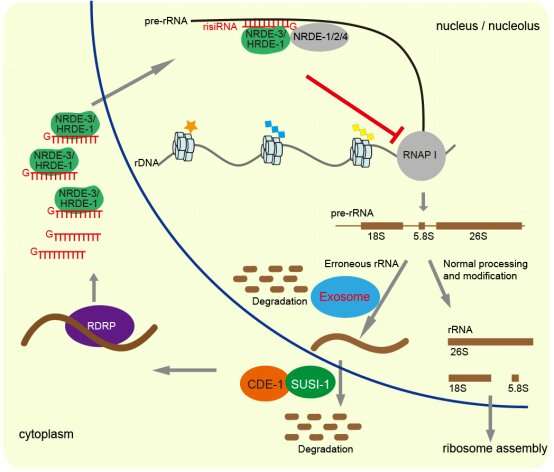Revealing the molecular mechanism of nucleolar RNA

A research group led by Prof. Guang Shouhong from the University of Science and Technology of China (USTC) of the Chinese Academy of Sciences, collaborating with Prof. Feng Xuezhu from the First Affiliated Hospital of USTC, revealed the nucleolar RNA interference based on Caenorhabditis elegans (C. elegans) as model organism. The study was published in Nuclear Acids Research.
siRNA is a kind of non-coding small RNA with a length of about 22 nucleotides. siRNA plays an important role in the growths and developments, reproductive genetics and immune defense of of the animal and plant body, and is an excellent drug molecule.
By using forward and reverse genetic screening, Prof. Guang's group has identified a series of suppressor of siRNA (SUSI) factors that inhibit endogenous siRNA production in C. elegans. When SUSI factor is defective, misprocessed ribosomal RNA (rRNA) fragments accumulate in cells, inducing the production of ribosomal siRNA (risiRNA). risiRNAs complement rRNA sequences and regulate the level of rRNA by activating the nuclear RNA interference pathway.
In this study, the researchers cloned a SUSI-5 gene that inhibits the production of risiRNA through genetic screening, and found that the SUSI-5 gene encodes a conserved catalytic subunit DIS-3 of RNA exosomes.
Through CRISPR gene editing technology, they confirmed that the functional defect of any subunit of RNA exosome could cause the accumulation of risiRNA, and risiRNA induces two nuclear RNA interference key factors, NRDE-2 and NRDE-3, to enter the nucleolus, bind ribosomal RNA precursors, and then inhibit the transcriptional activity of RNA polymerase.
Besides, the researchers found that RNA exosomes could respond to the homeostasis of rRNA in the nucleus through the change of subcellular localization. RNA exosomes play an important role in the processing and metabolism of a variety of RNA, and are mainly located in the nucleolus. The imbalance of intracellular rRNA homeostasis would lead to the transfer of RNA exosomes from nucleolus to nucleoplasm. The correct subcellular localization of RNA exosomes plays an important role in inhibiting the production of risiRNA.
This study established a new rRNA monitoring model which helps people to understand the biological roles and mechanisms of risiRNAs.
More information: Shimiao Liao et al, Antisense ribosomal siRNAs inhibit RNA polymerase I-directed transcription in C. elegans, Nucleic Acids Research (2021). DOI: 10.1093/nar/gkab662
Journal information: Nucleic Acids Research
Provided by University of Science and Technology of China




















